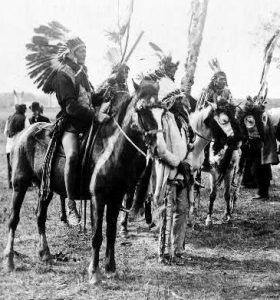By the time this skirmish occurred, Indian battles had become a thing of the past, and “civilization” had taken over Wyoming. However, on October 24, 1903, one more skirmish would occur. Also called the Battle of Lightning Creek, the conflict occurred after Weston County Sheriff William Miller received word that several bands of Indians were roaming the southern part of the county. The Indians, led by Chief Charley Smith, had left the Pine Ridge Reservation in South Dakota to hunt near Thunder Creek. Allegedly hunting illegally, the Indians had not only violated game laws but were also said to have killed some stock on the range. Sheriff Miller and a posse caught up with a portion of the band on October 23 and arrested 12 at the mouth of Lance Creek. The Indians were then disarmed and escorted back to Newcastle, Wyoming, by Deputy Hilton, Ed Buchanan, and Arthur Edlund.
The remaining posse members, including Sheriff Miller, then went after the rest of the band, catching up with them on the Dry Fork of the Cheyenne River. Finding a group of about 20 warriors and 30 women, he demanded that they surrender; however, Chief Charley Smith refused. Miller, in the meantime, realized he did not have enough men to make an arrest and withdrew. The next day after obtaining reinforcements, the posse caught up with the band near Lightning Creek and Thunder Creek confluence. Once again, Miller demanded that they surrender, but they refused, and one Indian opened fire on the posse. In the ensuing skirmish, Sheriff Miller suffered a fatal wound and bled to death, Deputy Louis Falkenberg was shot in the neck, five Indians were killed, and Chief Charley Smith was severely wounded. He died the next day.
The rest of the Indians fled and headed back to the reservation. Deputy Sheriff Lee Mather of Crook County and a posse set out to intercept the Indians in Edgemont, South Dakota. They were able to arrest nine braves and 12 women. The rest, it is believed, escaped to the reservation. Later, nine braves and 12 women of the band were caught by a Crook County posse led by Deputy Lee Miller in South Dakota. On November 12, a preliminary hearing was held in which the Indians pleaded innocence, admitting they were part of the hunting party but denying having any part in the battle. They were all discharged for lack of evidence. Wyoming Governor Chatterton, upon hearing the news of the Indians’ release, was outraged that the Indians had gotten away with not only the intentional murder of two fine lawmen but with the killing game and the stock of area ranchers as well. However, there was nothing he could do about it.
However, the Battle of Lightening Creek was not the last “Indian Scare” to hit the area. In 1906, approximately 400 members of the White River Band of Ute left the Uintah Reservation in Utah and crossed northern Wyoming on their way to the Pine Ridge Reservation, where they hoped to find refuge. Their trek was peaceful, except for some alleged theft from local ranches. However, the Press became overly excited, including the New York Times, which reported on October 31, 1906, that the Ute were prepared to fight to the death. When the Army intercepted them, 40 Indians elected to return to Utah, and the remainder were escorted to Fort Meade, South Dakota, and were later placed on the Cheyenne River Reservation. Two years later, they also elected to return to Utah.
Compiled by Kathy Alexander/Legends of America, updated March 2023.
Also See:

